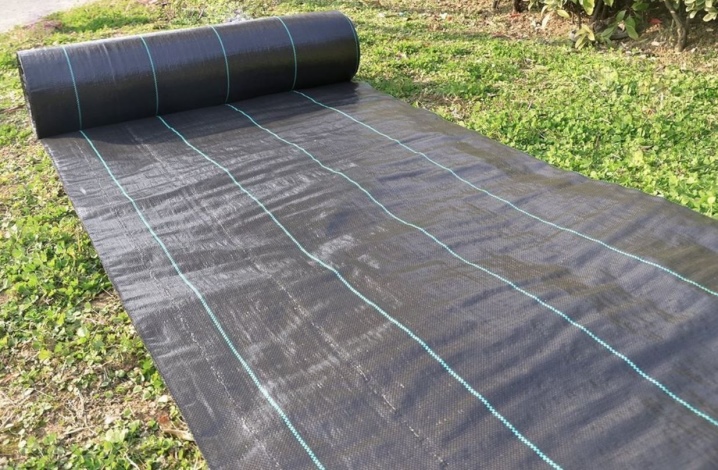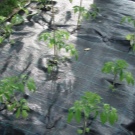How to choose an agrotechnical fabric?

Every gardener strives to grow as much harvest as possible on his garden plot. But weeds, insects, dry weather can sometimes cause great harm to crops. Several years ago, first in farms, and then in private plots, agro-fabric was used to care for agricultural crops.
What it is?
Agro-fabric is a material based on polypropylene that has a high density and the ability to withstand heavy loads. Thanks to the increased strength, you can walk on such a flooring without fear that the material will burst or become unusable.

Agrotechnical fabric is used in the form of flooring between cultural plantings. Most commonly used for mulching weeds.
In its structure, agrotechnical fabric resembles a bag of sugar or flour with markings in the form of squares applied to the surface. Such markings will help to make equal holes for plants at the same distance from each other.
Do not confuse agrotextile with agrofibre. The latter has a low density and can only serve to create greenhouses. Also, unlike agrotextile, agrofibre is not resistant to high pressure, and when stepped on it will tear, press into the ground and mix with it.


Types and features of material
Depending on the manufacturer, polypropylene agrotechnical fabric is available in 3 different colors:
- black;
- white;
- green.
Most often it is found on sale black agrotextile. Since black is the least susceptible to UV penetration, weed growth will be less under the black fabric.

White agrotextile most often used for covering the soil in greenhouses and greenhouse farms. White color reflects sunlight better than others, which contributes to faster ripening of fruits.

Green agrocloth it is used mainly in landscape design, when decorating flower beds, since a green color similar in color to grass looks more aesthetically pleasing.

In addition to its main function - protection against the germination of unnecessary weeds, agrotextile has other useful properties.
- It is able to pass air, water and mineral fertilizers due to its porous structure.
- It makes it possible to reduce the number of waterings.
- Prevents moisture from evaporating too quickly from the soil surface in dry weather.
- Protects the root system of plants from overheating or hypothermia through air circulation.
- Due to the fact that when laying agrotextile there is no need for weeding, all useful minerals remain in the soil, and its fertility increases.
- Protection of fruits from rotting due to the fact that the coating does not allow them to come into contact with the ground.
- Protection against pests such as slugs, worms, stick insects. Solid flooring will not allow parasites to penetrate the fruit.
- Frost protection for roots. With the onset of frosty weather and insufficient snow cover due to agrotechnical fabric, an additional layer is created for insulation.
- Ability to withstand temperature extremes. Due to this property, it will be enough to cover the dense polypropylene fabric once; it does not need to be removed for the winter period.



Another distinctive feature of dense agrofibre, as opposed to thinner agrofibre, is its high cost. The prices for agrotechnical fabric are 3-4 times higher compared to the prices for film or covering nonwoven fabric.But the service life of durable agrotechnical fabric is several times longer than the service life of cheaper materials and ranges from 10 to 15 years. Therefore, you should not save money when buying, since the agrotechnical fabric will recoup the costs after 3-4 years of its use.
Also, the covered agrotechnical fabric gives the site a well-groomed look. The landscape looks more aesthetically pleasing than, for example, covering open areas with boards or covering them with sawdust.

How to choose?
Before buying, please measure the part of the plantation that is planned to be covered with agrofibre... Depending on the results obtained, the width and length of the blade should be selected.
Agrofibre from different manufacturers is presented in different retail chains. The price for agro-fabric of foreign manufacturers differs significantly from the cost of polypropylene fiber of Russian companies. However, the quality of domestic fabric is not inferior to imported material. Therefore, if the purchase of flooring from a specific manufacturer is not required, then there is no point in overpaying.
On the shelves of hardware stores, agrotechnical fabric is presented rolled into a roll.
Therefore, when buying at the stage of measuring the required footage, you need to carefully monitor the absence of breaks, puffs or other external defects on the surface of the flooring. Since during operation, in the presence of a marriage, the fabric will wear out in this place much earlier than the due date.

Application methods
A dense covering cloth is used to protect the soil when planting many types of crops. The most common use of decking is for the following plants.
- Strawberries. To do this, the fabric is covered over the entire surface of the plantation, making the same holes on the surface of the fabric for each bush. Agro-fabric will protect not only from weeds, but also from rot and harmful insects.

- Tomatoes, peppers, cucumbers. Most often, these crops are planted in a greenhouse. It is necessary to cover with agrotechnical the distance between the ridges of the planted bushes. After placing the fabric between the plantings, you can safely walk on it, watering or harvesting without fear of spoiling the flooring.


- Kustarnikov. In this case, the agrotechnical fabric is laid around each bush so that from the base of the bush the fabric covers an area of at least 2 meters in each direction. When the polypropylene fabric is placed under the bushes, it mainly protects the roots from drying out. Sufficient moisture will help to prevent shedding of the berries, they will be larger.

- Fruit and berry and ornamental trees. If the trees are planted in rows, then the entire soil surface under the trees is to be covered. If it is necessary to protect the soil under a single tree, then it is necessary that the entire root system be covered with agrotex. This is approximately 2 meters on each side of the trunk.

- Flowers. When creating compositions, flower beds and flower beds from ornamental plants. If you lay agrotechnical fabric between the rows of flowering plants, the flowerbed will look well-groomed, weeding of the flower garden will not be required, which will protect cultivated plants from accidental pulling out along with weeds.
As in the case of shrubs, agrotextile protects the roots of trees from a lack of moisture. Therefore, the trees, under which the flooring is made of agrotextile, will bear fruit longer, the fruits will be larger, and they will crumble less before ripening.

Thus, knowing about all the advantages and useful properties of agrotextile, you can no doubt purchase such a material to protect and simplify maintenance on your site. The effect of using dense polypropylene fabric will be especially noticeable if the vegetable garden or garden has a large area.
In the next video, you will learn how agrotextile is used to control weeds.



































































The comment was sent successfully.